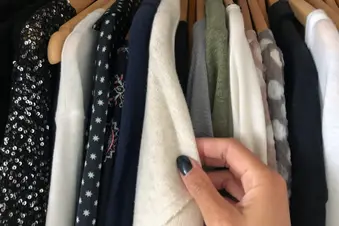
If you have chronic spontaneous urticaria (CSU), also called chronic hives, the clothes you wear may affect the condition.
Wearing the right clothes can make your skin feel better and keep hives at bay. But certain materials, chemicals, and clothing features can aggravate your skin, make itching worse, and cause your hives to spread.
Here are some tips for what to wear and what to avoid when you have CSU.
Choose Loose-Fitting, Lightweight Clothes
“Loose-fitting clothing is preferred,” says Viktoryia Kazlouskaya, MD, a dermatologist and dermatopathologist at Khrom Dermatology & Aesthetics in Brooklyn, NY.
Light, loose clothes help your skin breathe. On the other hand, pressure from tight clothes may irritate your skin and make your hives worse.
Look for Gentle Materials
When you shop, choose clothing that’s soft, smooth, and gentle on your skin.
“Look for natural soft materials, loose-fitting designs, and light colors, especially if you’re sensitive to dyes,” Kazlouskaya says.
Soft, natural materials include:
- Cotton
- Linen
- Silk
If you choose a synthetic or semi-synthetic material, such as viscose, make sure it’s soft so it’s gentler on your skin.
Try not to wear clothes that are rough or scratchy. “Wool and nylon clothing should be worn with caution,” Kazlouskaya says. These materials may scratch your skin and make your hives flare up.
If you wear clothing that’s not gentle on your skin, try wearing soft underwear underneath so there’s a barrier between your skin and the fabric.
Get a Proper Fit
If your clothes don’t fit well, they may rub against your skin. This creates friction, which may make your hives worse.
“Avoid clothes that are too tight or fit poorly,” Kazlouskaya says. This also applies to shoes. If your shoes are too tight or too loose, they may cause friction and irritate your skin.
Avoid Clothing Features That Put Pressure on Your Skin
Some clothing features put pressure on your skin and can lead to problems.
“Tight elastic bands, like in some socks and undergarments, are a common trigger,” says Kara Wada, MD, an allergist and immunologist at the Ohio State University Wexner Medical Center in Columbus. Avoid these clothing features if you can.
Avoid Accessories That Cause Irritation
Even the bag you use to carry personal items can make CSU worse. If a bag or a bag strap rests against your body, it can irritate your skin.
“Avoid wearing heavy purses and backpacks if pressure is a trigger,” Wada says.
Pressure from wearing belts can also make hives worse. Try a loose waistband instead. “If a belt is needed, it’s best to stick to elastic waistbands and elastic belts,” she says.
Protect Your Skin From Heat and Sunlight
Heat can make itching worse.
Try to stay out of direct sunlight. If you’re in the sun, wear protective clothing.
“Some folks will find getting too warm exacerbates the itching associated with hives,” Wada says. “Dressing in layers and breathable fabrics can help you cool off.”
Protect Your Skin From the Cold
If low temperatures are a trigger for you, try to avoid exposing your skin to cold air. If you’re outside in cold weather, cover up with warm clothing. Consider using a scarf to protect your nose and mouth.
Wash New Clothes Before You Wear Them
Certain chemicals used in clothing production may cause an allergic reaction. “The most common ones are dyes and formaldehyde used for wrinkle-free clothes,” Kazlouskaya says.
Dimethyl fumarate, a chemical used to prevent mold growth in clothes, can also trigger hives. “The use of this chemical is banned in the U.S. and the European Union, but some cheap stores may still sell products with this substance,” Kazlouskaya says.
Wash Your Clothes With a Gentle Detergent
“Fragrances, colors, and emulsifiers in detergents may potentially cause contact urticaria,” Kazlouskaya says.
Choose a fragrance-free, dye-free detergent. Look for one that’s made for sensitive skin.
For added protection from chemicals, try running your clothes through an extra rinse cycle and avoid dryer sheets.
Embrace New Styles
If you’re used to form-fitting clothes, wearing looser styles may be an adjustment. But there are many ways to look stylish with different types of clothes.
Have fun mixing and matching styles. “Try to combine them,” Kazlouskaya says. “For example, wear wide pants with a well-fitting blouse.”
Try small changes. “Clothing doesn’t have to be super baggy,” Wada says. “Just choose something that’s loose enough for your skin to breathe.
“And remember,” she says, “comfort is key, especially if you’re itchy.”
Show Sources
Photo Credit: RooM RF / Getty Images
SOURCES:
Viktoryia Kazlouskaya, MD, PhD, dermatologist and dermatopathologist, Khrom Dermatology & Aesthetics, Brooklyn, NY.
Kara Wada, MD, clinical assistant professor of otolaryngology, Ohio State University Wexner Medical Center.
Allergy Institute: “Don’t Scratch That Itch! Understanding Hives and How to Find Relief.”
American Academy of Dermatology Association: “10 ways to get relief from chronic hives.”
American College of Allergy, Asthma & Immunology: “Hives.”
Columbia University Irving Medical Center: “Hives/Urticaria.”
Mayo Clinic: “Hives and angioedema.”